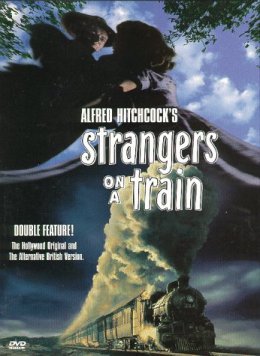Strangers on a Train review by Jackass Tom
Chance Encounter
The first images we see of STRANGERS ON A TRAIN are the two pairs of shoes of two very different men. One is of an extravagant black and white pair of shoes; obviously a man of boisterous personality. The other is conservative pair all dark and not even polished, worn by a normal man who seems to blend in. Both men board the same train, The next shot we see is of a number of train tracks passing and overlapping each other; each set crossing just once and before going their separate ways into infinity. The two men sit down next to each other, the conservative shoe bumps his foot into the flashier shoe, and suddenly as their paths cross we see their faces. Then the usual Hitchcock themes begin to arise.
After a few drinks, Bruno (Robert Wagner) the man with the black and white shoes begins discussing his theories of murder because after all, “anyone is capable of murder.” Bruno learns that Guy (Farley Granger) has a scheming, manipulative wife that he could live without but can’t divorce. Bruno cannot stand his father for whatever reason, so he brings up the idea of swapping murders. No one would ever expect either one to commit the murder they did commit and both would be innocent of the ones that would be expected to commit (it almost needs a flow chart). In theory it would be the perfect crime. Guy takes none of what Bruno says seriously, but yet, Bruno is quite serious.
Bruno follows Guy’s wife through an amusement park as she fools around drunkenly with two other men. When she sneaks away from the two men, there is Bruno to greet her. In classic Hitchcock form we watch the silent strangling though the reflection in the victims fallen glasses. In order to cover himself, Bruno rushes to tell Guy the good news. Hitchcock does a fabulous job of creating guilt within the main character. Obviously he feels he had something to do with it since he told this stranger how much he hated his wife, and although he didn’t physically murder her, Bruno has him “acting like a criminal.”
The character of Bruno is one of Hitchcock’s most interesting villains. While in public he seems charming in a wild and out-going man, yet in private he is a deeply disturbed and unaffected by his criminal actions. His family and home are just as strange. His mother is an aloof airhead and seems to have no clue about what her son does when he is away. She talks to him like he is still child and discusses such strange matters as him ‘blowing up the White House.’ Her insanity is also reflected in an unsettling painting she had made (which Bruno laughs because somewhere in it he sees his father).
Bruno takes an unnatural and obsessive interest in Guy, almost like a stalker (“Why didn’t you answer my calls, Guy?”). The obsession over Guy draws pretty close to take a homosexual affection; a “Cable Guy-like” man crush twist as he works his way into Guy’s life. His sudden appearances create an unsettling atmosphere for the lead character.
Of course there are a number of classic Hitchcock shots, most of them involving Guy as he tries to avoid Bruno. As Guy rides away in a cab, we see a tracking shot from his perspective of a small figure on the steps of the Lincoln Memorial. His face is not clear, but you can tell by his motionless stare and trademark hat who it is. Later in the film, there is shot of a crowd watching a tennis match. Everyone is moving their head in unison with the tennis ball (a classic tennis cliché). The camera zooms up on the only man remaining still (Bruno), whose face is fixed on Guy warming up on the next court.
Unfortunately the film slows down in places mainly in the middle where Guy is trying to prove his innocence. I suppose this is necessary to prolong the suspense and guilt of the character but it takes away from the true pleasures of the film: the camera work and the villain. The casual moviegoers should get their money’s worth out of this, but it’s the Hitchcock fans will definitely revel in this dark horse classic.
I love watching trailers of these older films. One of the tags for this movie was “You’ll talk to your friends about it but you’ll never talk to STRANGERS ON A TRAIN!” Talk about an isolationist’s ideal. Also the DVD contains two different cuts: one Hollywood version and one alternative British version that looks deeper into Bruno’s psyche.







7 out of 10 Jackasses blog comments powered by Disqus
Search
Strangers on a Train

IMDB Link: Strangers on a Train
DVD Aspect Ratio: 1.33:1
DVD Extras: Two movie versions, 5 trailers, silent newsreel.